ISSN ONLINE(2319-8753)PRINT(2347-6710)
ISSN ONLINE(2319-8753)PRINT(2347-6710)
V. R Rathi1 and P. K. Kolase2
|
| Related article at Pubmed, Scholar Google |
Visit for more related articles at International Journal of Innovative Research in Science, Engineering and Technology
Delay in concreting due to various conditions as well as improper casting sequence can result in cold joints. For unusually long delays during concreting, the concrete should be kept alive by periodically re-vibrating it to keep concrete workable. However, concrete should not be over-vibrated to the point of causing loss in homogeneity. This study gives strength data simulating such improper casting sequences. To cope this problem related to improper casting sequence, which ultimately results in formation of cold joints, we have used sugar as retarding agent. To prove this we conducted experiments on three types of concrete of M25 grade, such as stained concrete, stained concrete with retarding agent and fresh concrete. The experimental results of compressive, flexural and split tensile strength with above three types of concrete shows that stained concrete with retarding agent gives improved strength as compare to stained and fresh concrete in horizontal failure plane.
Keywords |
| cold joint, improper casting sequence, retarding agent (sugar), stained concrete. |
INTRODUCTION |
| It is very difficult to cast the whole structure monolithically and also the construction joints are very important in the structure for the expansion and contraction of the concrete. Also the amount of the concrete to be placed is depends on the mixing capacity of plant crew sizes. The correctly designed, located and constructed joints do not affect the strength of the concrete. For many structures, it is impractical to place concrete in a continuous operation. Construction joints are needed to accommodate the construction sequence for placing the concrete. The amount of concrete that can be placed at one time is governed by batching and mixing capacity, crew size, and the amount of time available. Correctly located and properly executed construction joints provide limits for successive concrete placements, without adversely affecting the structure. |
| A plane of weakness or discontinuity formed when a batch of concrete hardens before the next batch is placed against it is called cold joint. A cold joint is usually characterized by poor bond unless remedial measures are taken before placing concrete against a previously hardened batch. To avoid cold joints, placing should be resumed substantially before the time of initial set. For unusually long delays during concreting, the concrete should be kept alive by periodically revibrating it. However, concrete should not be over-vibrated to the point of causing segregation. Furthermore, should the concrete approach time of initial setting, vibration should be discontinued and the concrete should be allowed to harden. A cold joint will result, and suitable surface preparation measures should be applied. When, in practice, either casting cannot be completed in one go or there is a time lapse between mixing and placing, the strength of the final product is affected. The strength could also depend on the plane where casting at two different points in time meet. This study gives strength data simulating such improper casting sequences. |
| Delay in concreting, resulting the cold joints and it affect concrete strength minor to very major reduction. The most important problem with cold joint is possibility of the moisture into the concrete section and if this happened there is degradation of the concrete due to availability of the water in cold joint. Following are some cause result in improper casting sequence:- |
| 1. Delay in casting or mixing due to time gaps |
| 2. Due to delay in transportation of concrete from RMC plant to project site location |
| 3. Extension of the incomplete construction on next day |
| 4. Due to shortage of constituents of concrete |
EXPERIMENTAL STUDIES |
A. Material Properties |
| Cement: (OPC53 grade) Cement which used during whole casting was from same batch and properties of the cement used are shown in Table 1. |
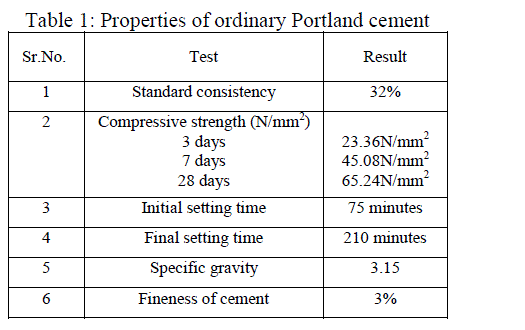 |
| Following the methods prescribed in the Indian standard code, the mix proportioning for M25 grade concrete was worked out. |
Retarding Agent |
| Retarding agents means the admixture which delay the hydration of cement i.e. increases the setting time. In this project we use the sugar as a retarding agent and the amount of sugar is 0.1% due to which the initial setting time increase up to 195 minutes and final setting time is increase up to 315 minutes. And the above table (table 1) indicates the data for the IST and FST without sugar. |
Casting procedure:- |
| Before the casting, the oiling to the surface of the mould is carried out. This is done for to avoid the bonding between concrete and the inner surface of the mould. Now the following are the procedure used during fresh concreting, stain concreting and stain concreting with retarding agent. |
Stain Concrete:- |
| The mix is cast immediately after the mixing but only the half of the mould is fill and the remaining half mould is fill with the same concrete is fill after the times laps of 45 min., 75 min., 120 min. and 180min. The times delay in casting is to be done to study the behavior for the joints under compressive ,split tensile and flexural strength. |
Fresh Concrete |
| The specimen for the fresh concrete is produced by the preparing fresh concrete for half mold. And for the remaining half filling of the mould the concrete is prepared (i.e. freshly mix) with the times laps of 45min, 75min, 120min and 180min. i.e. Fresh concrete is mix for each mold having the times gap as mention above. The main difference between the stained concrete and fresh concrete is the stained concrete is totally mix for the total no. of mould in single stage and fill that concrete in times laps and the fresh concrete the new concrete is prepared for every times laps every time. |
| The waterproof thin paces of plywood is used for the producing the joint surface. The three main types of the joints are vertical, diagonal and horizontal (Fig.1) |
 |
B. Hard concrete test result and graphs: |
| Testing of hardened concrete plays an important role in controlling and confirming the quality of cement concrete work. Tests are made by casting cubes, beams and cylinder from the actual concrete. The samples are tested for compressive, split tensile and flexural strength for 3days, 7days and 28 days. |
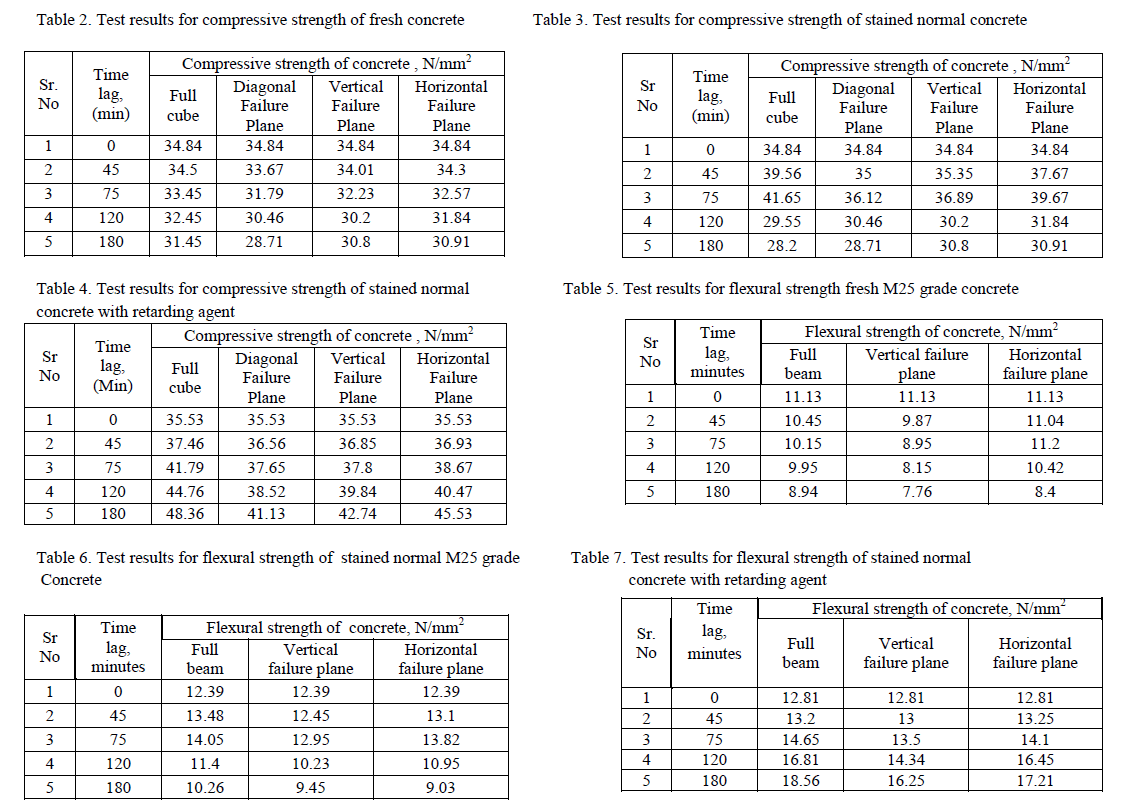 |
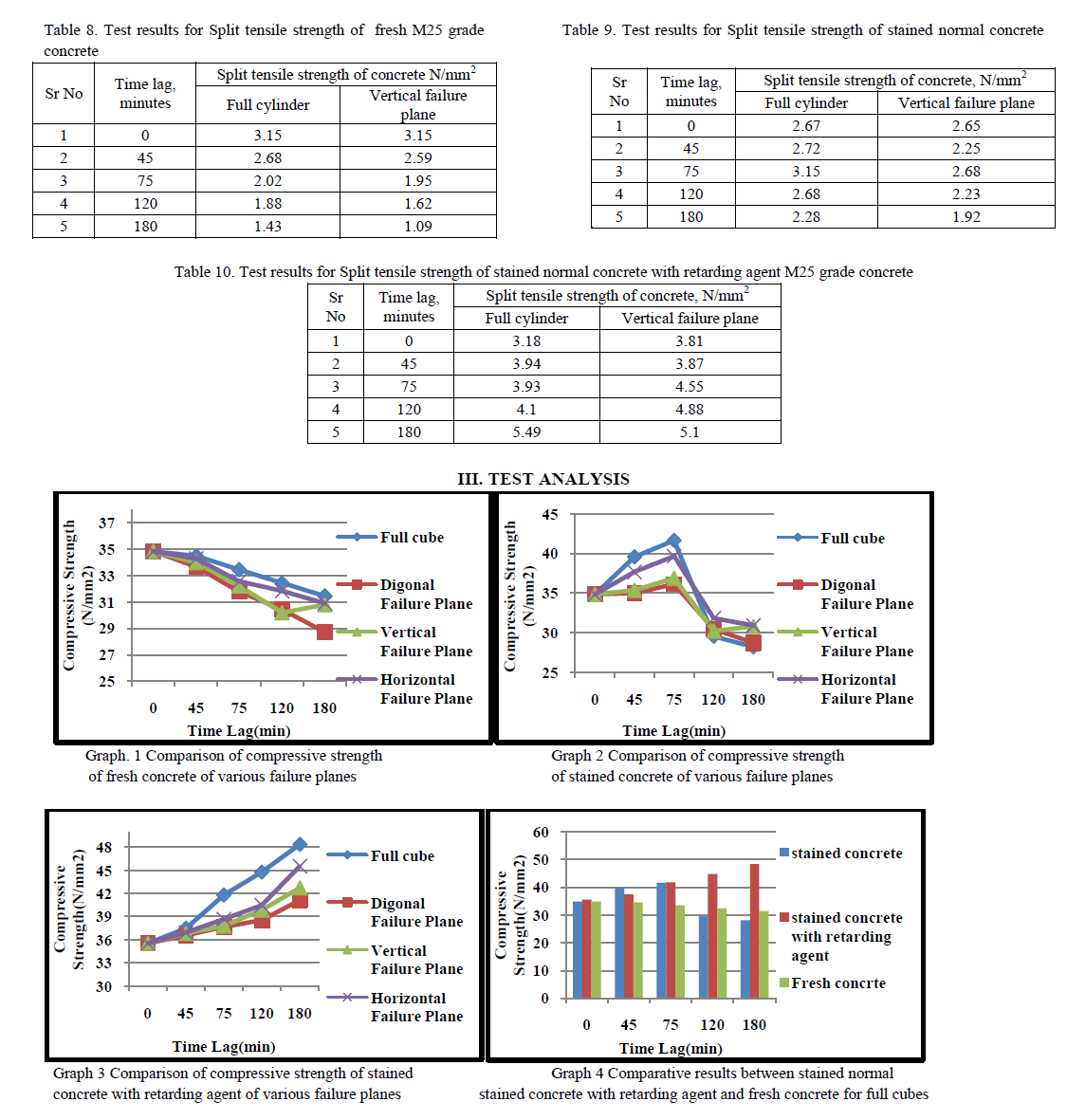 |
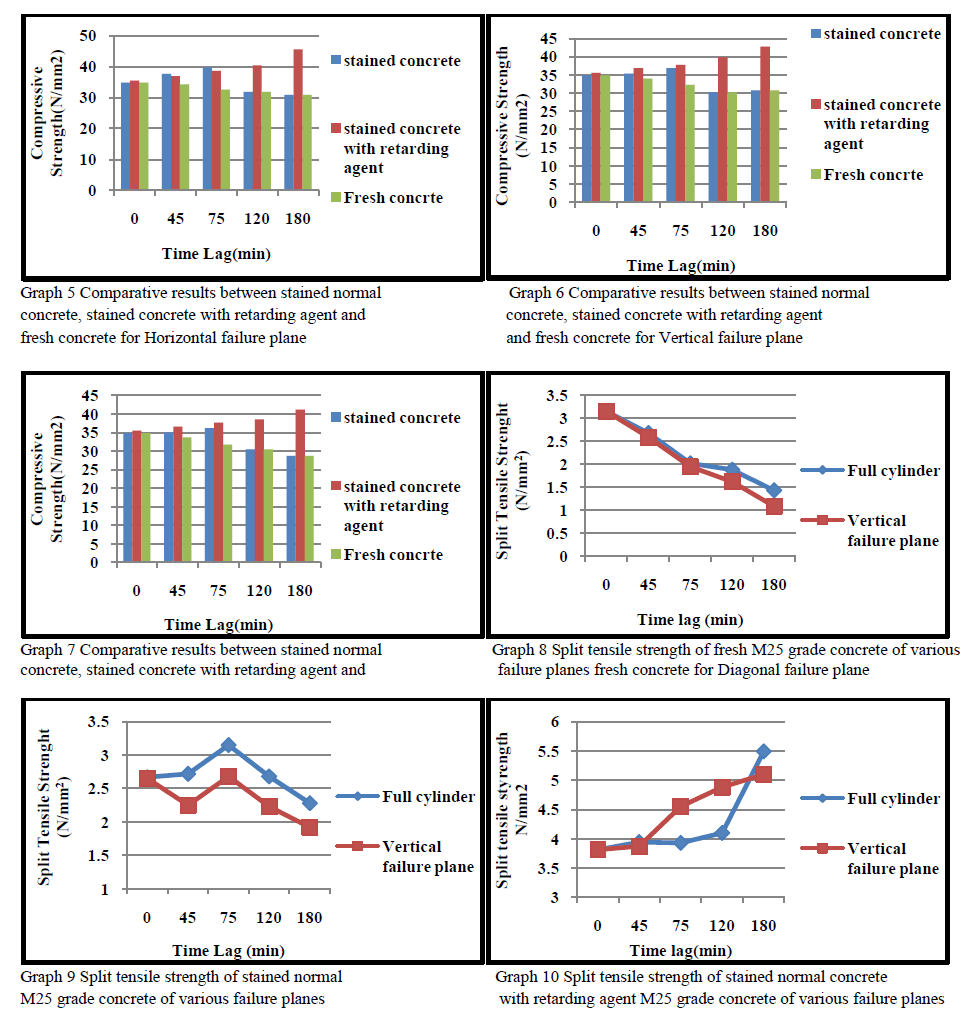 |
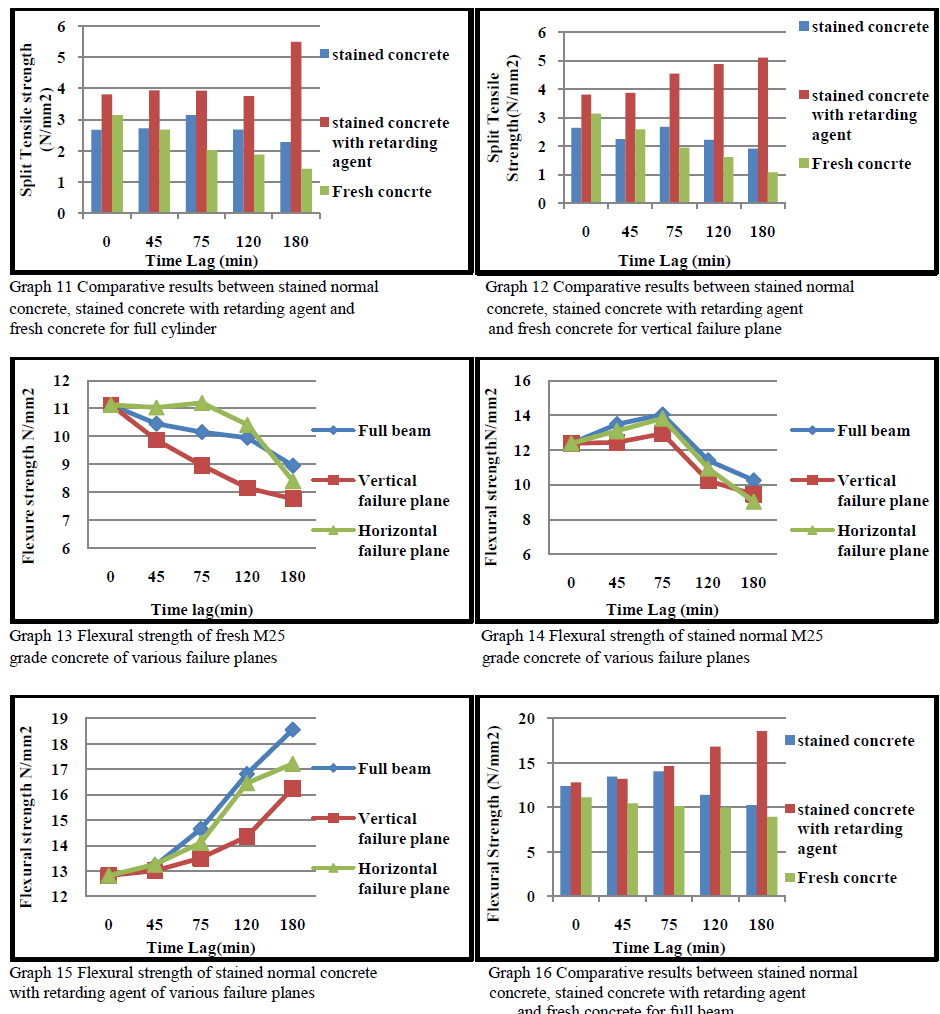 |
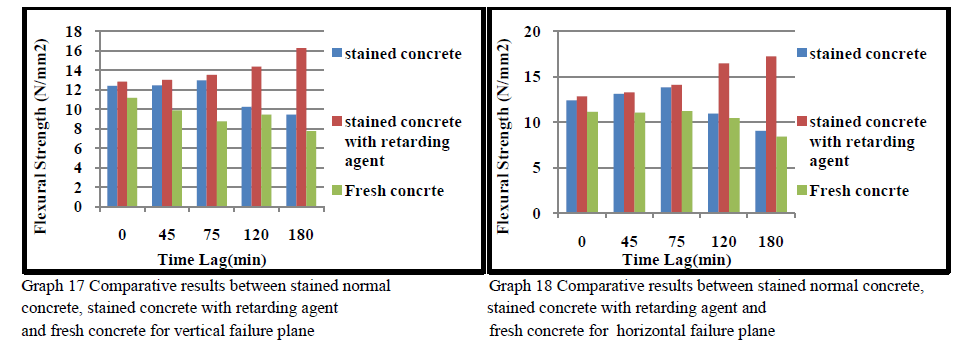 |
Interpretation of results. |
| 1. Graph 1, 8 and 13 suggest that the compressive, flexure and split tensile strength of fresh concrete decrese at slower rate with the delay in casting. The horizontal failure plane performed better than the other planes. The decrease of compressive, flexure and split tensile strength in other cases may be due to improper bonding between the two layers as the water cement ratio varies in both the layers. |
| 2. Graph. 2, 9 and 14 show the testing result of stained normal concrete graphically. We conclude that the strength of the full cubes, beams and cylinder is more than the cubes, beams, cylinder having failure plane. It can notice that compressive strength of full cubes, beams, cylinders increases initially and then decreases as the time lag between mixing and casting increases. The increase is reflected up to 75 min that is, the initial setting time of cement. Since most of the initial hydration take place within the initial setting time, the compressive, flexure and split tensile strength of the concrete decreases for the time lag exceeding the initial setting time. This observation was made for specimens with diagonal, horizontal and vertical failure plane. |
| 3. So that to overcome this problem, we increased the IST and FST of the cement by adding 0.1% of sugar as a retarding agent. As a result, the strength of concrete increased even after 180 min delay in casting. |
| 4. Graph 1, 8 and 13 suggest that the compressive, flexure and split tensile strength of fresh concrete decrese at slower rate with the delay in casting. The horizontal failure plane performed better than the other planes. The decrease of compressive, flexure and split tensile strength in other cases may be due to improper bonding between the two layers as the water cement ratio varies in both the layers. |
| 5. Graph. 2, 9 and 14 show the testing result of stained normal concrete graphically. We conclude that the strength of the full cubes, beams and cylinder is more than the cubes, beams, cylinder having failure plane. It can notice that compressive strength of full cubes, beams, cylinders increases initially and then decreases as the time lag between mixing and casting increases. The increase is reflected up to 75 min that is, the initial setting time of cement. Since most of the initial hydration take place within the initial setting time, the compressive, flexure and split tensile strength of the concrete decreases for the time lag exceeding the initial setting time. This observation was made for specimens with diagonal, horizontal and vertical failure plane. |
| 6. So that to overcome this problem, we increased the IST and FST of the cement by adding 0.1% of sugar as a retarding agent. As a result, the strength of concrete increased even after 180 min delay in casting. |
| 7. It can be noticed from Graph 3, 10 and 15 that adding 0.1% of sugar as a retarding agent increase the setting time . As the result,a continuous increse in compressive, flexure and split tensile strength for full cubes, beams, cylinder and cubes, beams, cylinder with digonal, vertical, horizontal failure plane observed. The horizontal failure plane is again the best one among the cubes, bems and cylinder. |
| 8. Graph 1, 2, 3, 8, 9, 10, 13, 14, and 15 shows that the percentage loss in compressive, flexure and split tensile strength was minimum in the case of horizontal failure plane as compared to digonal and vertical failure plane for different time intervals. |
| 9. Only increse the setting time but also the compressive, flexure and split tensile strength of the failure planes increase with respect to time lag and the compressive, flexure and split tensile strength of fresh concrete decrease with respect to time lag. |
| 10. Among all the observations it can be conclude that horizintal failure plane is best with respect to all failure planes. |
CONCLUSION |
| Following conclusion are drawn on the result discussed in the previous chapter: |
| 1. As in the case of the stained normal concrete the strength of the concrete is increase till the initial setting time of cement (75 minutes) and later on for a time lag exceeding the initial setting time, it decreases. |
| 2. From Experimental study it is observed that, In case of full cubes the compressive, split tensile, flexural strength for stained concrete with retarding agent compared with stained concrete without retarding agent increases by 19.62%,23.35% and 57.41% respectively. |
| 3. From Experimental study it is observed that, In case of full cubes the compressive, split tensile, flexural strength for normal concrete compared with stained concrete without retarding agent decreases by 4.11%, 17.79% and 17.41% respectively. |
| 4. From Experimental study it is observed that, In case of full cubes the compressive, split tensile, flexural strength for stained concrete with retarding agent compared with normal concrete increases by 19.84%, 33.46% and 47.52% respectively. |
| 5. From Experimental study it is observed that, In case of horizontal failure plane the compressive, split tensile, flexural strength for stained concrete with retarding agent compared with stained concrete without retarding agent increases by 12.71%, 87.23% and 24.50% respectively. |
| 6. From Experimental study it is observed that, In case of horizontal failure plane the compressive, split tensile, flexural strength for normal concrete compared with stained concrete without retarding agent decreases by 5.97%, 11.48% and 12.05% respectively. |
| 7. From Experimental study it is observed that, In case of horizontal failure plane the compressive, split tensile, flexural strength for stained concrete with retarding agent compared with normal concrete increases by 16.58%, 52.72% and 29.27% respectively. |
| 8. From Experimental study it is observed that, In case of vertical failure plane the compressive, flexural strength for stained concrete with retarding agent compared with stained concrete without retarding agent increases by 14.67% and 21.67% respectively. |
| 9. From Experimental study it is observed that, In case of vertical failure plane the compressive, flexural strength for normal concrete compared with stained concrete without retarding agent decreases by 3.5% and 15.40% respectively. |
| 10. From Experimental study it is observed that, In case of vertical failure plane the compressive, flexural strength for stained concrete with retarding agent compared with normal concrete increases by 15.85% and 41.05% respectively |
| 11. In the case of stained normal concrete the compressive, flexure and split tensile strength reduced below the target mean strength (33.75 N/mm2) for a time lag exceeding the final setting time of cement i.e. 210 min. |
| 12. The amount of retarding agent used in this study is about 0.1% of the total weight of cement as it is effective, after performing the setting time test. |
| 13. Among the different failure planes the decrease in compressive, flexure and split tensile strength was least in the case of horizontal plane as compared to vertical and diagonal planes. |
| 14. From Experimental study it is observed that after initial setting time also slump value is satisfactory after addition of retarding agent it will be helpful if there is delay in concreting |
References |
|